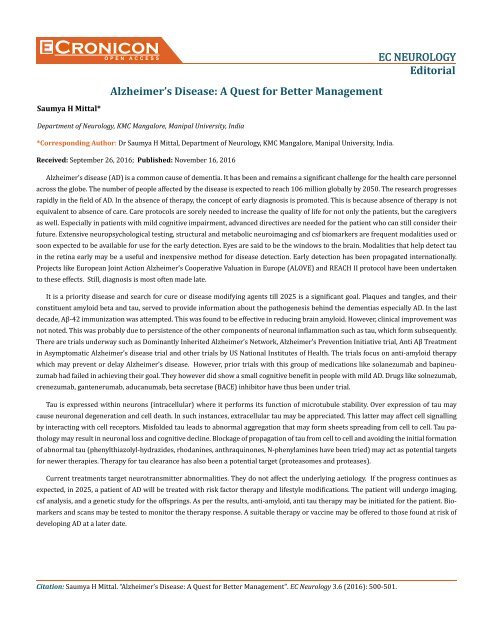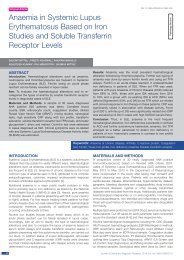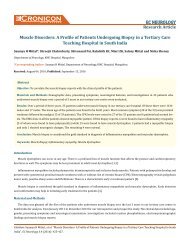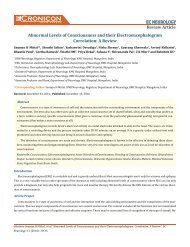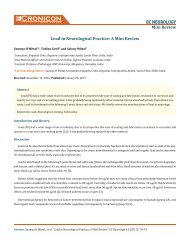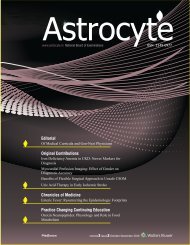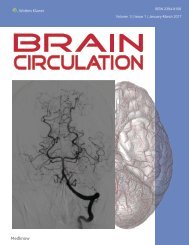Alzheimer’s Disease A Quest for Better Management
Create successful ePaper yourself
Turn your PDF publications into a flip-book with our unique Google optimized e-Paper software.
Cronicon<br />
OPEN ACCESS<br />
EC NEUROLOGY<br />
Editorial<br />
<strong>Alzheimer’s</strong> <strong>Disease</strong>: A <strong>Quest</strong> <strong>for</strong> <strong>Better</strong> <strong>Management</strong><br />
Saumya H Mittal*<br />
Department of Neurology, KMC Mangalore, Manipal University, India<br />
*Corresponding Author: Dr Saumya H Mittal, Department of Neurology, KMC Mangalore, Manipal University, India.<br />
Received: September 26, 2016; Published: November 16, 2016<br />
<strong>Alzheimer’s</strong> disease (AD) is a common cause of dementia. It has been and remains a significant challenge <strong>for</strong> the health care personnel<br />
across the globe. The number of people affected by the disease is expected to reach 106 million globally by 2050. The research progresses<br />
rapidly in the field of AD. In the absence of therapy, the concept of early diagnosis is promoted. This is because absence of therapy is not<br />
equivalent to absence of care. Care protocols are sorely needed to increase the quality of life <strong>for</strong> not only the patients, but the caregivers<br />
as well. Especially in patients with mild cognitive impairment, advanced directives are needed <strong>for</strong> the patient who can still consider their<br />
future. Extensive neuropsychological testing, structural and metabolic neuroimaging and csf biomarkers are frequent modalities used or<br />
soon expected to be available <strong>for</strong> use <strong>for</strong> the early detection. Eyes are said to be the windows to the brain. Modalities that help detect tau<br />
in the retina early may be a useful and inexpensive method <strong>for</strong> disease detection. Early detection has been propagated internationally.<br />
Projects like European Joint Action <strong>Alzheimer’s</strong> Cooperative Valuation in Europe (ALOVE) and REACH II protocol have been undertaken<br />
to these effects. Still, diagnosis is most often made late.<br />
It is a priority disease and search <strong>for</strong> cure or disease modifying agents till 2025 is a significant goal. Plaques and tangles, and their<br />
constituent amyloid beta and tau, served to provide in<strong>for</strong>mation about the pathogenesis behind the dementias especially AD. In the last<br />
decade, Aβ-42 immunization was attempted. This was found to be effective in reducing brain amyloid. However, clinical improvement was<br />
not noted. This was probably due to persistence of the other components of neuronal inflammation such as tau, which <strong>for</strong>m subsequently.<br />
There are trials underway such as Dominantly Inherited <strong>Alzheimer’s</strong> Network, <strong>Alzheimer’s</strong> Prevention Initiative trial, Anti Aβ Treatment<br />
in Asymptomatic <strong>Alzheimer’s</strong> disease trial and other trials by US National Institutes of Health. The trials focus on anti-amyloid therapy<br />
which may prevent or delay <strong>Alzheimer’s</strong> disease. However, prior trials with this group of medications like solanezumab and bapineuzumab<br />
had failed in achieving their goal. They however did show a small cognitive benefit in people with mild AD. Drugs like solnezumab,<br />
crenezumab, gantenerumab, aducanumab, beta secretase (BACE) inhibitor have thus been under trial.<br />
Tau is expressed within neurons (intracellular) where it per<strong>for</strong>ms its function of microtubule stability. Over expression of tau may<br />
cause neuronal degeneration and cell death. In such instances, extracellular tau may be appreciated. This latter may affect cell signalling<br />
by interacting with cell receptors. Misfolded tau leads to abnormal aggregation that may <strong>for</strong>m sheets spreading from cell to cell. Tau pathology<br />
may result in neuronal loss and cognitive decline. Blockage of propagation of tau from cell to cell and avoiding the initial <strong>for</strong>mation<br />
of abnormal tau (phenylthiazolyl-hydrazides, rhodanines, anthraquinones, N-phenylamines have been tried) may act as potential targets<br />
<strong>for</strong> newer therapies. Therapy <strong>for</strong> tau clearance has also been a potential target (proteasomes and proteases).<br />
Current treatments target neurotransmitter abnormalities. They do not affect the underlying aetiology. If the progress continues as<br />
expected, in 2025, a patient of AD will be treated with risk factor therapy and lifestyle modifications. The patient will undergo imaging,<br />
csf analysis, and a genetic study <strong>for</strong> the offsprings. As per the results, anti-amyloid, anti tau therapy may be initiated <strong>for</strong> the patient. Biomarkers<br />
and scans may be tested to monitor the therapy response. A suitable therapy or vaccine may be offered to those found at risk of<br />
developing AD at a later date.<br />
Citation: Saumya H Mittal. “<strong>Alzheimer’s</strong> <strong>Disease</strong>: A <strong>Quest</strong> <strong>for</strong> <strong>Better</strong> <strong>Management</strong>”. EC Neurology 3.6 (2016): 500-501.
<strong>Alzheimer’s</strong> <strong>Disease</strong>: A <strong>Quest</strong> <strong>for</strong> <strong>Better</strong> <strong>Management</strong><br />
Such novel diagnostic modalities and treatment protocols would be welcomed across the globe by all healthcare personnel involved<br />
in management of <strong>Alzheimer’s</strong> disease.<br />
501<br />
Volume 3 Issue 6 October 2016<br />
© All rights reserved by Saumya H Mittal.<br />
Citation: Saumya H Mittal. “<strong>Alzheimer’s</strong> <strong>Disease</strong>: A <strong>Quest</strong> <strong>for</strong> <strong>Better</strong> <strong>Management</strong>”. EC Neurology 3.6 (2016): 500-501.


